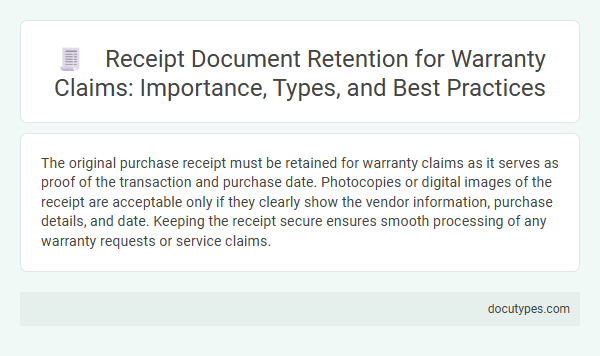The original purchase receipt must be retained for warranty claims as it serves as proof of the transaction and purchase date. Photocopies or digital images of the receipt are acceptable only if they clearly show the vendor information, purchase details, and date. Keeping the receipt secure ensures smooth processing of any warranty requests or service claims.
Introduction to Receipt Document Retention for Warranty Claims
Receipt documents serve as crucial proof of purchase for warranty claims. Retaining the correct receipt ensures a smooth process when requesting repairs or replacements. Understanding which receipt to keep helps protect your consumer rights effectively.
Importance of Keeping Receipts for Warranty Verification
Receipts serve as essential proof of purchase required for warranty claims. They provide verified details such as purchase date, product name, and seller information.
Keeping receipts ensures smooth verification during the warranty process and protects your consumer rights. Without a valid receipt, companies often reject warranty requests, making retention critical.
Types of Receipts Relevant for Warranty Claims
Receipts that include detailed purchase information such as the date, item description, and seller's details are essential for warranty claims. These documents serve as proof of purchase and validate the warranty period.
Types of receipts relevant for warranty claims include printed receipts, electronic receipts, and order confirmation emails. Warranty claims often require the original receipt or an officially recognized digital copy to ensure authenticity.
Legal Requirements for Receipt Retention
Legal requirements for receipt retention vary by jurisdiction but typically mandate keeping proof of purchase for warranty claims. Receipts should clearly display the date of purchase, seller details, and product description to ensure validity. Retaining original receipts or verified digital copies is essential to safeguard your warranty rights.
Digital vs. Physical Receipt Storage: Pros and Cons
Receipt documents are essential for warranty claims, serving as proof of purchase. Choosing between digital and physical receipt storage affects how easily you can access and manage these records.
Digital receipts offer convenience, easy organization, and reduced risk of physical damage or loss. They can be stored securely in cloud services, allowing quick retrieval during warranty claims. Physical receipts, however, provide a tangible backup but are prone to fading, damage, or misplacement over time.
Recommended Retention Periods for Receipts
Retaining the correct receipt document is essential for successful warranty claims. Recommended retention periods vary depending on the product type and warranty terms.
- Original Purchase Receipt - Keep this document as proof of purchase for the entire warranty period, typically ranging from one to five years.
- Extended Warranty Documents - Retain any additional warranty agreements or service contracts until the extended coverage expires.
- Repair and Service Receipts - Maintain records of repairs and maintenance performed during the warranty period to support future claims.
Best Practices for Organizing and Storing Receipts
| Receipt Document | Reason for Retention | Best Practices for Organizing and Storing |
|---|---|---|
| Original Purchase Receipt | Proof of purchase date and price required for warranty validation. | Keep a physical copy in a dedicated folder labeled by year or product category. |
| Warranty Card or Certificate | Confirms warranty terms and coverage details. | Store together with the purchase receipt in the same folder or envelope. |
| Digital Receipt or Email Confirmation | Backup proof of purchase in case the original is lost or damaged. | Save in a cloud storage service with clear file names including product and date. |
| Repair or Service Receipts | Support claims related to repairs during the warranty period. | Organize chronologically in a separate section or folder dedicated to service documentation. |
| Extended Warranty Documentation | Evidence for additional warranty coverage beyond the standard period. | Keep alongside original warranty card and note expiration dates clearly. |
| Photographs of the Item and Receipt | Visual evidence in case of damage or disputes over ownership. | Store digital photos with receipts in your organized cloud folders. |
Common Mistakes in Receipt Retention for Warranty Purposes
Retaining the correct receipt document is crucial for successful warranty claims. Many people make avoidable errors that can invalidate their warranty rights.
- Discarding Original Receipts - Losing the original proof of purchase often causes claim rejections since digital copies may not be accepted.
- Failing to Keep Receipt Details - Missing information like purchase date, store name, or product details can make it difficult to verify the warranty validity.
- Ignoring Store or Manufacturer Policies - Not understanding which receipts qualify for warranty purposes may lead to keeping incorrect documents.
You should always keep the original, fully detailed receipt according to the warranty provider's guidelines to ensure smooth claim processing.
Handling Lost or Faded Receipts in Warranty Claims
Which receipt document is necessary for warranty claims and how should one handle lost or faded receipts?
The original purchase receipt is essential for proving warranty eligibility and validating the claim. In cases of lost or faded receipts, contacting the retailer for a duplicate or using bank statements as proof of purchase can serve as effective alternatives.
Which Receipt Document Should Be Retained for Warranty Claims? Infographic

